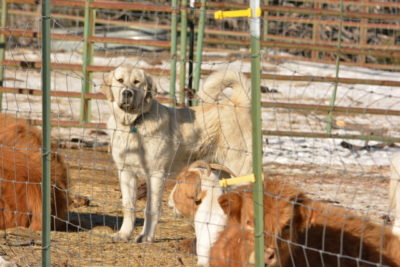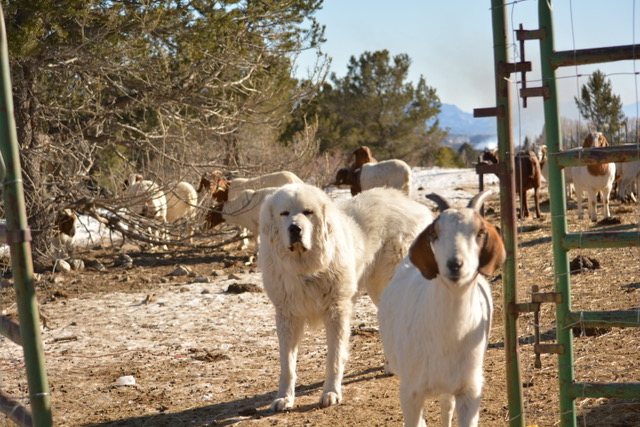The Role of Working Dogs in Agricultural Economics
It’s a rancher’s nightmare; nighttime forays by coyotes, bears, and cougars attacking and carrying off their livestock. For generations, the best protection farmers and ranchers have had against such predators has been working dogs, guarding the flocks and herds, warning off the attackers.

The Livestock Guardian dogs owned by the Carrigan family, are working dogs whose job it is to protect their herds of goats and Highland cattle. Courtesy photos.
While city people may view the agricultural vistas and bucolic atmosphere as “scenic rural living,” country people know that their agricultural livelihoods depend upon protection of their investments, grazing on four legs on those fields. Here in Chaffee County, at least one farmer who relies on working guardian dogs to protect his flock has been repeatedly reported to the county for dog barking violations.
The continuing situation threatens their livelihood and has seen them repeatedly in court, costing them thousands of dollars to defend themselves.
“We are a ranch family being harassed by Chaffee County,” say John and Aja Carrigan, whose goat ranch north of Buena Vista at 17560 CR 386, is the subject of complaints by one of their neighbors. “Each time the neighbor files a complaint with the county, the Sheriff’s Office visits and issues a dog barking ticket.”

The Carrigan dogs stay with the herds 24 hours a day, guarding against attacks by the numerous predators in nearby BLM lands. courtesy photo.
It has not seemed to matter that the six working dogs that guard the Carrigan’s herds are not pets. Two are Great Pyrenees (known as the Pyrenean Mountain Dog outside of North America), two are Anatolian Shepherds and two others are an Akbash mix. These large dog breeds are bred specifically as livestock guardian dogs for agricultural operations. They guard the Carrigan’s Boer, Kiko and Kiko-Boer meat goats, Nubian miking goats and Highland cattle.
“My dogs bark at night when predators come to kill my goats and cattle. This is their job. They are not pet dogs. They are livestock guardians protected by state law,” said John Carrigan.
All fifty states have enacted right-to-farm laws that seek to protect qualifying farmers and ranchers from nuisance lawsuits filed by individuals who move into a rural area where normal farming operations exist, who use nuisance actions to attempt to stop those ongoing operations.
The state of Colorado has strong Right to Farm regulations (Colorado’s Right to Farm law C.R.S. 35-3.5-101, 102) that recognize the rights of ranchers and farmers to protect their agricultural operations. Most were put in place in the early 1970s and 1980s as urban sprawl began to put agricultural operations in conflict with newly-arrived city neighbors, unfamiliar with the sights, sounds and smells of commercial agricultural operations.

The Carrigans own six working dogs, specifically bred as livestock guardian dogs. Two of the six are Great Pyrenees, one pictured here. Courtesy photo.
Specifically, the Colorado Right to Farm law says “An agricultural operation shall not be found to be a public or private nuisance if the agricultural operation alleged to be a nuisance employs methods or practices that are commonly or reasonably associated with agricultural production … any ordinance or resolution of any unit of local government that makes the operation of any agricultural operation a nuisance, or provides for the abatement thereof as a nuisance under the circumstances set forth in this section, is void.”
It goes on to say that local governments “may adopt an ordinance or pass a resolution that provides additional protection for agricultural operations.” In other words — local governments can add more protection for agricultural activities — but they can’t take away the protections afforded by state government.
Those state regulations cover canine working dogs, including herding dogs and livestock guardians. But here in Chaffee County, two realities appear to be undermining the rights of agricultural producers and setting Chaffee County at odds with the state’s regulation. The first; a less-than-transparent effort has weakened the county’s Right to Farm protections for the county’s agricultural working dogs. Second; a decision by the Chaffee County Sheriff’s office appears to favor enforcement of residential-oriented dog barking ordinances, over rural Right to Farm protections for farmers and ranchers.
Over the past two years Chaffee County has set a limit of seven as the number of dogs allowed to reside on rural land parcels. The recent Chaffee Animal Control ordinance no longer has provision for Right to Farm protections; completely eliminating the agricultural exemption for working dogs, regardless of the size of herds which may require the protection of more than seven working dogs.
“We have six legal guardian dogs (LGD’s) and one border collie,” said Carrigan. “We came to Chaffee County, bought a ranch and use the property to raise primarily Boer Goats. Where our ranch is, we have a heavy predator load in coyotes, cougars, bears, and maybe soon, even wolves. Basically, the county is completely ignoring state ag law and enforcing the barking ban.”
Oddly enough, if you are a hunter and your dog is barking, you won’t get cited by the Chaffee County Sheriff’s Office. But if you have one neighbor who complains about your agricultural working dogs, you can end up in court, as Alison Brown did in the case of her American Foxhounds on her property at 11600 Antelope Road. The Carrigans face the same prospect.
“We’ve gotten 17 tickets for dogs barking,” said Aja Carrigan. “When they bark in the middle of the night, they are warning that a coyote pack or a cougar is near the herd, or on the property. They sound danger. My gosh – that’s their job. The Sheriff’s deputies are nice when they show up, but we still get a ticket, and the legal costs for defending ourselves for simply running our ranch are mounting.
Carrigan said that the complaints are from a single neighbor, who has a trailer right on their property line. She reports that he has stood at the property line yelling and screaming at them and their dogs, although they have done everything they can think of to create distance. The fencing for their herds and guardian dogs is set back 200 ft. from their own property line.
John Carrigan says that when that neighbor calls the Sheriff’s Office, deputies come and park at end of the road to listen for the length of time of a barking session and the amount of time between barking sessions. Then they issue citations. They don’t seem to have determined whether or not there are predators in the area.
There has also been aggression toward the Carrigan’s property signage from an unknown source. “Twice someone has damaged the signs at the entrance to our ranch that say our farm has working dogs,”said Carrigan. “Once could be an accident. We put up a second sign with contact info for people to call to make appointments for things like gas and electric meter reading, and someone has damaged that sign too.”
In the past, some Chaffee residents having extensive experience with canine agricultural use have offered to serve on working groups to make practical suggestions for how to balance the needs of ranchers with those who continue to move into the country for “the rural way of life”. Chaffee County has thus far ignored those offers.
The Carrigans are scheduled to be back in court on dog barking violations on January 15.
Coming up: Part II, The breeding of working dogs, and legal actions in other states upholding Right to Farm laws.








Properly trained and used working dogs do not bark unless a REAL threat is detected. Rustling leaves, racoons, chipmunks, wind in the trees, twittering birds and other harmless night time noises are not a threat. Well trained herder dogs rely on SCENT not NOISES to sound the alarm. These dogs are not apparently well trained and instead of “working” dogs, have been allowed to become “nuisance” dogs. There is a difference. And using the cover of the right to farm law as cover is NOT acceptable and or fair to people who have and maintain well trained “working Dogs! I would think that Chaffe County should also make sure these dogs are properly vaccinated as most state laws require
I further suggest that these “so called ranchers” use trained llama’s to guard their herds. They are far more effective, and quieter than “nuisance dogs”
Yes, Chaffee County IS harassing this Farmer! I don’t understand how Chaffee County can get away with this harrassment. This farmer is using a traditional, widely accepted method of predator control, Livestock Guardian Dogs. Their job is to keep predators off the property. They do that by barking. Predators can be animal, or human. Where is this farmers Right To Farm? How is that being ignored? I read in the article that there have been attempts to fix the situation, but Chaffee County is refusing. Why? What is their reason for not working with this farmer?
I’m looking forward to Part 2 and a solution to this problem.
Great Reporting!